Readings Newsletter
Become a Readings Member to make your shopping experience even easier.
Sign in or sign up for free!
You’re not far away from qualifying for FREE standard shipping within Australia
You’ve qualified for FREE standard shipping within Australia
The cart is loading…






Quantum Field Theory has become the universal language of most modern theoretical physics. This introductory textbook shows how this beautiful theory offers the correct mathematical framework to describe and understand the fundamental interactions of elementary particles. The book begins with a brief reminder of basic classical field theories, electrodynamics and general relativity, as well as their symmetry properties, and proceeds with the principles of quantisation following Feynman’s path integral approach. Special care is used at every step to illustrate the correct mathematical formulation of the underlying assumptions. Gauge theories and the problems encountered in their quantisation are discussed in detail. The last chapters contain a full description of the Standard Model of particle physics and the attempts to go beyond it, such as grand unified theories and supersymmetry. Written for advanced undergraduate and beginning graduate students in physics and mathematics, the book could also serve as a reference for active researchers in the field.
$9.00 standard shipping within Australia
FREE standard shipping within Australia for orders over $100.00
Express & International shipping calculated at checkout
Quantum Field Theory has become the universal language of most modern theoretical physics. This introductory textbook shows how this beautiful theory offers the correct mathematical framework to describe and understand the fundamental interactions of elementary particles. The book begins with a brief reminder of basic classical field theories, electrodynamics and general relativity, as well as their symmetry properties, and proceeds with the principles of quantisation following Feynman’s path integral approach. Special care is used at every step to illustrate the correct mathematical formulation of the underlying assumptions. Gauge theories and the problems encountered in their quantisation are discussed in detail. The last chapters contain a full description of the Standard Model of particle physics and the attempts to go beyond it, such as grand unified theories and supersymmetry. Written for advanced undergraduate and beginning graduate students in physics and mathematics, the book could also serve as a reference for active researchers in the field.